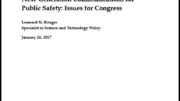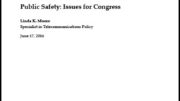Linda K. Moore
Specialist in Telecommunications Policy
May 28, 2013
Summary
Since September 11, 2001, when communications failures contributed to the tragedies of the day,
Congress has passed several laws intended to create a nationwide emergency communications
capability. Yet the United States has continued to strive for a solution that assures seamless
communications among first responders and emergency personnel at the scene of a major disaster.
To address this problem, Congress included provisions in the Middle Class Tax Relief and Job
Creation Act of 2012 (P.L. 112-96) for planning, building, and managing a new, nationwide,
broadband network for public safety communications, and assigned additional spectrum to
accommodate the new network. In addition, the act has designated federal appropriations of over
$7 billion for the network and other public safety needs. These funds will be provided through
new revenue from the auction of spectrum licenses. The cost of construction of a nationwide
network for public safety is estimated by experts to be in the tens of billions of dollars over the
long term, with similarly large sums needed for maintenance and operation. In expectation that
public-private partnerships to build the new network will reduce costs to the public sector, the law
has provided requirements and guidelines for shared use.
The act has mandated that technical standards developed for the new network incorporate
commercial standards for Long Term Evolution (LTE). LTE is a fourth-generation wireless
technology that bases its operating standards on the Internet Protocol (IP). IP-enabled networks
and wireless devices provide higher capacity and transmission speeds than earlier generations of
technology. LTE represents the convergence of wireless technology with the Internet, bringing the
capacity and resiliency of packet-switched networks to emergency communications. It is
generally believed that the use of LTE and IP standards will greatly enhance communications for
emergency response and recovery.
There are many challenges for public safety leaders and policy makers in establishing IP-enabled
technologies as the baseline for the development of future solutions for response and recovery.
One of the immediate challenges in developing standards is the need for a clear policy on the use
of spectrum for commercial and public safety LTE. Because public safety planning has lagged
behind commercial efforts to build LTE networks, the work on design and development of
technical requirements is incomplete. Many experts are concerned that these delays may place
public safety officials at a disadvantage in negotiating with potential partners, increase costs, and
add further delays in moving forward to build a nationwide broadband network. Requirements in
the act for standards development may be insufficient to overcome current technical obstacles for
desired network features such as roaming between public safety and commercial networks.
In addition to monitoring progress in building the new broadband network for public safety,
Congress may want to consider reviewing the role of commercial networks in emergency
response and recovery. Once commercial communications lines are compromised because of
infrastructure failures, interdependent public safety networks are threatened and the ability to
communicate vital information to the public is diminished. New policy initiatives may be needed
to identify critical gaps in communications infrastructure and the means to fund the investments
needed to close these gaps.





Be the first to comment on "The First Responder Network and Next-Generation Communications for Public Safety: Issues for Congress 2013"